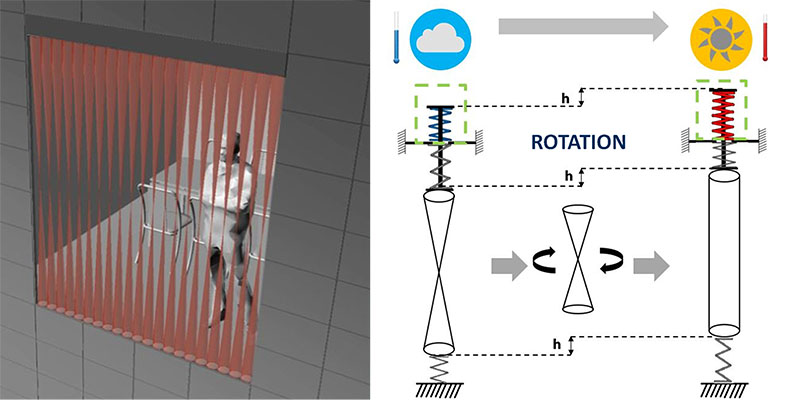Downloads
DOI:
https://doi.org/10.7480/jfde.2020.1.4700Keywords:
Passive adaptive, shading system, shading device, dynamic, innovative, double-skin, shape memory alloy springs, solar radiation, daylightAbstract
A shading device for façade application was developed by combining twisting cylindrical shading elements with the smart use of shape-memory alloy (SMA) components. These allow a dynamic behaviour of a shading device, which does not require electrical motors or manual activation, nor sophisticated electronic controls. The technical development of the system involved research of cylindrical shading geometries, which can transition from straight to hourglass configuration, given a 180° rotation, with limited mechanical movement. This is induced by the stroke of a SMA spring, which functions as both actuator and sensor. Its design is tailored to achieve a passive adaptive component that can be activated under set temperature stimuli, caused by incident solar radiation on a façade. A combination of computer simulations and physical tests were carried out to assess the optimal conditions of the SMA spring activation in a temperate climate condition (Cfa to the Koppen-Geiger classification), correlating transition temperature (50°C), incident solar radiation (>300W/m2 ) and the forces required to operate the cylinders. In parallel, an experimental apparatus was developed to validate the concept on a geometrical point of view, and to ensure its constraints were compatible with a SMA spring control system.
How to Cite
Published
Issue
Section
License

This work is licensed under a Creative Commons Attribution 4.0 International License.
Authors or their institutions retain copyright to their publications without restrictions.
References
Coelho, M., & Maes, M. (2009). Shutters : A Permeable Surface for Environmental Control and Communication. Proceedings of Tangible and Embedded Interaction (TEI '09), 13-18. https://doi.org/10.1145/1517664.1517671
Coelho, M., & Zigelbaum, J. (2011). Shape-changing interfaces. Personal and Ubiquitous Computing, 15, 161-173. https://doi.org/10.1007/s00779-010-0311-y
Fiorito, F., Sauchelli, M., Arroyo, D., Pesenti, M., Imperadori, M., Masera, G., & Ranzi, G. (2016). Shape Morphing Solar Shadings: A Review. Renewable and Sustainable Energy Reviews, 55, 863-884. https://doi.org/10.1016/j.rser.2015.10.086
Gonzalez, N. (2015). Self-Adaptive Membrane. Retrieved from http://www.iaacblog.com/programs/self-adaptive-membrane-_-a-passive-kinetic-system/.
Heschong, L. (2002). Daylighting and Human Performance. ASHRAE Journal, 44(6), 65-67.
LIFT Architects (2015). The air flower. Retrieved from http://www.liftarchitects.com/air-flower.
Luna, I. (2014). Shape Memory Alloy responsive façade. Retrieved from http://www.behance.net/gallery/SMAShape-Memory-Alloy/10797251.
Mainini, A.G., Speroni, A., & Vercesi, L. (2018). System for shielding and controlling sun light or the light flow coming from artificial sources, especially for application to buildings. Patent n° WO2018116102-A1.
Mazzucchelli, E. S., Romano, R., Aelenei, L., & Gomes, M.G. (2018). Passive Adaptive Façades – Examples from COST TU1403 Working Group 1. Delft, NL: TU Delft Open.
Menzies, G. F., & Wherrett, J. R. (2005). Windows in the workplace: examining issues of environmental sustainability and occupant comfort in the selection of multi-glazed windows. Energy and Buildings, 37(6), 623-630. https://doi.org/10.1016/j.enbuild.2004.09.012
Nielsen, M. V., Svendsen, S., & Jensen, L. B. (2011). Quantifying the potential of automated dynamic solar shading in office buildings through integrated simulations of energy and daylight. Solar Energy, 85(5), 757-768. https://doi.org/10.1016/j.solener.2011.01.010
Orangevoid (2007). Pixel skin interactive façade. Retrieved from http://fachadasmediales.blogspot.com/2007/12/pixel-skin-interactive-façade.html
Otsuka, K., & Ren, X. (2005). Physical Metallurgy of Ti–Ni-Based Shape Memory Alloys. Progress in Materials Science, 50(5), 511-678, https://doi.org/10.1016/j.pmatsci.2004.10.001.
Palmero-Marrero, A. I., & Oliveira, A. C. (2010). Effect of louver shading devices on building energy requirements. Applied Energy, 87(6), 2040-2049. https://doi.org/10.1016/j.apenergy.2009.11.020
Sandoval, J. (2012). Gill_Project performance. Retrieved from http://www.youtube.com/watch?v=-X_KxijpJT0.
Tzempelikos, A., & Athienitis, A. K. (2007). The impact of shading design and control on building cooling and lighting demand. Solar Energy, vol. 81(3), 369-382. https://doi.org/10.1016/j.solener.2006.06.015
Verma, S. (2016). Adaptive Skin. Retrieved from http://www.designboom.com/project/adaptive-skins-2/ .
Wang, F., Pichatwatana, K., Roaf, S., Zhao, L. Zhu, Z., & Li, J. (2014). Developing a weather responsive internal shading system for atrium spaces of a commercial building in tropical climates. Building and Environment, 71, 259-274. https://doi.org/10.1016/j.buildenv.2013.10.003
Decker, M., & Yeadon, P. (2010). SmartScreen: Controlling Solar Heat Gain with Shape Memory Systems. Decker Yeadon LLC. https://archinect.com/news/article/88265/smart-materials-move-smartscreen
